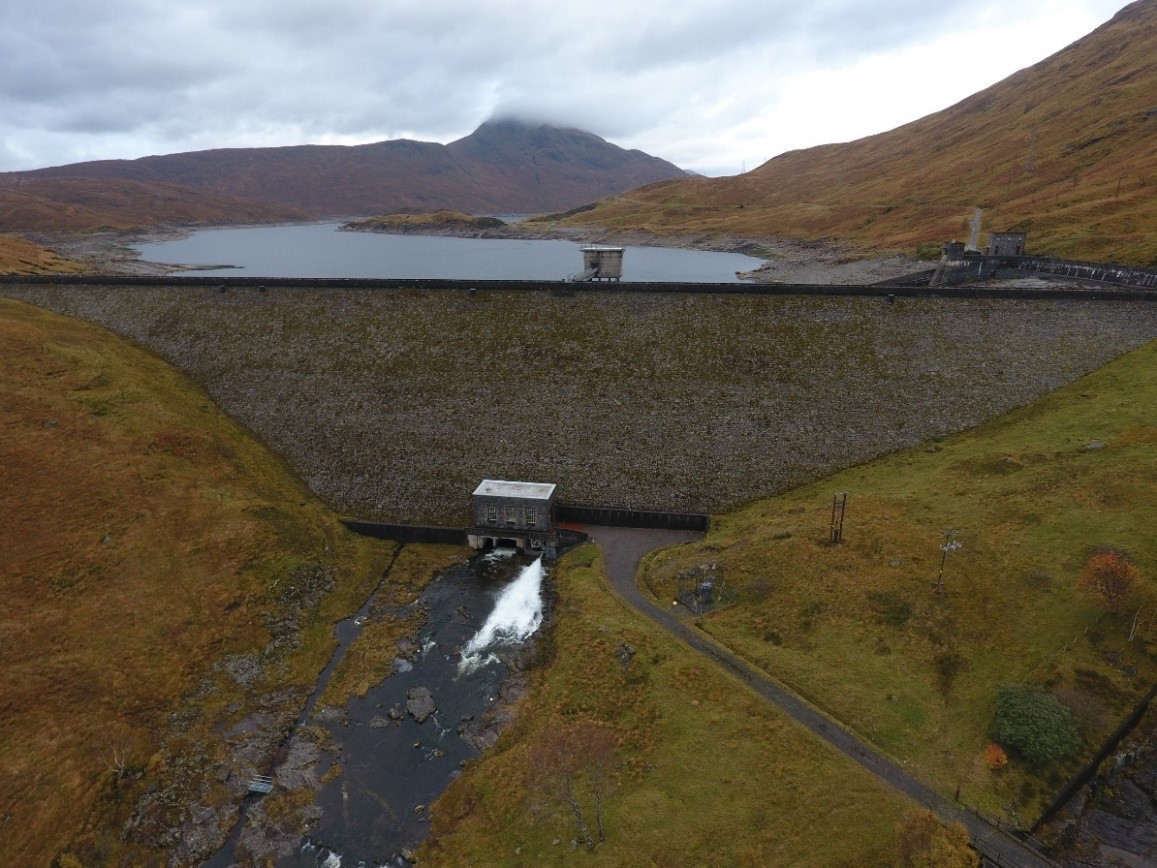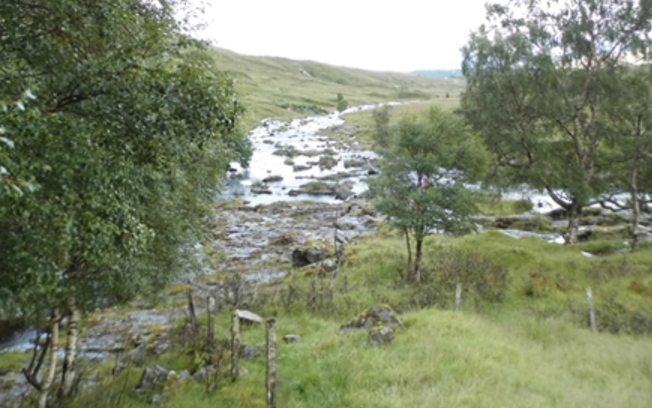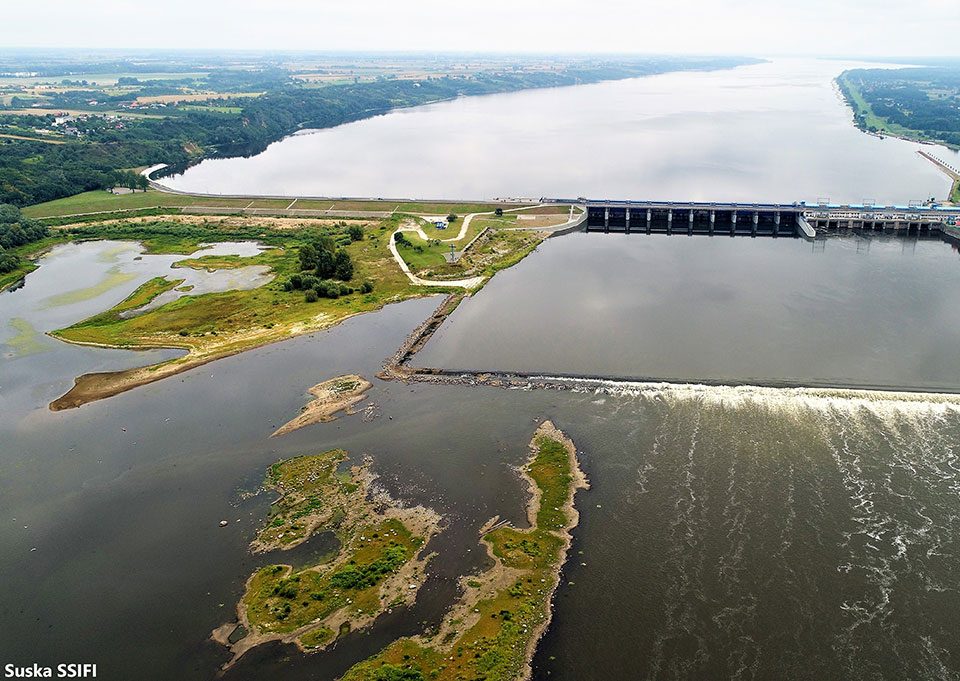Case Study Number: 4
Dam name: Quoich Dam
River name: Garry
AMBER TOOLS: Molecular toolkit (D2.5), MesoHABSIM (D2.6), Ecosystem Services Survey, Social survey (D3.5)
River name: Garry
AMBER TOOLS: Molecular toolkit (D2.5), MesoHABSIM (D2.6), Ecosystem Services Survey, Social survey (D3.5)
THE NEED
The case study focused on the assessment of ecosystem restoration needs arising from the presence and operation of hydroelectric dams on the River Garry, one of the main tributary rivers within the Ness catchment.
The two dams in the catchment are two of the five hydropower dams comprising the Great Glen Hydropower Scheme, the other three being located on the River Moriston. A very significant reduction in the salmon population of the River Garry following installation of the dams, and the ongoing efforts at mitigating these impacts, prompted the choice of this river system as the case study for applying the barrier impact tools and adaptive management framework developed within AMBER.
Understanding the conservation challenge of this iconic and economically important fish species requires consideration of broader river ecology and connectivity issues, as well as of the social, cultural and economic context.
The two dams in the catchment are two of the five hydropower dams comprising the Great Glen Hydropower Scheme, the other three being located on the River Moriston. A very significant reduction in the salmon population of the River Garry following installation of the dams, and the ongoing efforts at mitigating these impacts, prompted the choice of this river system as the case study for applying the barrier impact tools and adaptive management framework developed within AMBER.
Understanding the conservation challenge of this iconic and economically important fish species requires consideration of broader river ecology and connectivity issues, as well as of the social, cultural and economic context.
Problems
- Reduced river connectivity
- Reduction in salmon population
- mitigation of barrier impacts

Ness Catchment and subcatchments (image courtesy of the Ness District Salmon Fishery Board).
WHAT WE DID
The Ness catchment has been under intense study for the past five years, through AMBER and other initiatives, and there is great potential for a comprehensive adaptive management framework to be developed, bringing together researchers and relevant stakeholders.
AMBER Developed use of the eDNA tool for barrier assessment, carried out drone survey and sediment analysis, implemented MesoHABSIM habitat assessment, placed temperature sensors below barriers in collaboration with the Scotland River Temperature Network initiative, discussed barrier management practices , investigated the historical, cultural and linguistic background for the case study, conducted interviews and workshops with members of the local community and carried out water quality sample collection and analysis in parallel with eDNA water sample collection.
AMBER Developed use of the eDNA tool for barrier assessment, carried out drone survey and sediment analysis, implemented MesoHABSIM habitat assessment, placed temperature sensors below barriers in collaboration with the Scotland River Temperature Network initiative, discussed barrier management practices , investigated the historical, cultural and linguistic background for the case study, conducted interviews and workshops with members of the local community and carried out water quality sample collection and analysis in parallel with eDNA water sample collection.
Tools
- Molecular toolkit (D2.5)
- MeshoHABSIM D2.6, Ecosystem Services Survey (D2.7)
- Social survey (D3.5)

Quoich Dam – aerial drone photograph
NOW WHAT
Within the constraints of the primary focus of the project on the Upper Garry, a catchment-wide approach (the hallmark of any adaptive management strategy) was sought, and the core eDNA analysis of barrier impacts for the Great Glen Hydro Scheme was extended to eDNA analysis of Loch Ness and eDNA analysis of the presence of salmon in the Caledonian Canal.
Flooding due to hydro dams has eliminated 40% of salmon habitat and some of the remaining habitat has been altered in character. Alterations on the Gearr Garry below Quoich Dam are hypothesised to arise from sourcing of compensation flows from the bottom of the reservoir affecting water temperature and chemistry, stream sediments and, thus, habitat quality and biodiversity. No salmon spawning or juveniles now occur in the Gearr Garry and salmon production from the remaining accessible habitat is lower than expected.
This AMBER case study, a partnership with SSE and NDSFB, aims to put the UGSRP, and other initiatives, into a comprehensive biological-socio-economic barrier assessment and ecosystem restoration framework to advance understanding of biodiversity impacts, mitigation needs and optimal management solutions.

View from Quoich Dam spillway
WHO WAS INVOLVED
Development of the case study was made possible through a variety of different partnerships. At the onset of the project, the RLI partnered with the Ness District Salmon Fishery Board and with Scottish and Southern Energy (SSE), the hydropower company that owns the Great Glen Hydropower Scheme.
As the case study progressed, more partnerships evolved including with the Scotland River Temperature Network initiative, Marine Scotland Science (MSS), the scientific division of Marine Scotland, the Scottish Environmental Protection Agency (SEPA), the National Centre for Gaelic Language and Culture - Samhal Mor Ostaig College, UHI), Glengarry Heritage Centre, the Environmental Research Institute UHI (ERI), the Funaqua consortium, the Loch Ness Hunters project and the Missing Salmon Project.
As the case study progressed, more partnerships evolved including with the Scotland River Temperature Network initiative, Marine Scotland Science (MSS), the scientific division of Marine Scotland, the Scottish Environmental Protection Agency (SEPA), the National Centre for Gaelic Language and Culture - Samhal Mor Ostaig College, UHI), Glengarry Heritage Centre, the Environmental Research Institute UHI (ERI), the Funaqua consortium, the Loch Ness Hunters project and the Missing Salmon Project.
FURTHER READING
References
Atkinson, S., Carlsson, J.E.L., Ball, B., Egan, D., Kelly-Quinn, M., Whelan, K., Carlsson, J. 2018. A quantitative PCR-based environmental DNA assay for detecting Atlantic salmon ( Salmo salar L.). Aquatic Conserv: Mar Freshw Ecosyst 28: 1238–1243. https://doi.org/10.1002/aqc.2931
Baisez, A., J.-M. Bach, C. Leon, T. Parouty, R. Terrade, M. Hoffmann & P. Laffaille. 2011. Migration delays and mortality of adult Atlantic salmon Salmo salar en route to spawning grounds on the River Allier, France. Endangered species research 15:265-270.
Barry, J., Coghlan, B., Cullagh, A., Kerr, J. R. & King, J. J. 2018. Comparison of coarse-resolution rapid methods for assessing fish passage at riverine barriers: ICE and SNIFFER protocols. River Research and Applications, 34(9), 1168-1178.
Barry, J., Mc Loone, P., Fitzgerald, C., King, J.J. (In Press) The Spatial ecology of Brown Trout (Salmo trutta) and Dace (Leuciscus leuciscus) in an artificially impounded riverine habitat: results from an acoustic telemetry study. Aquatic Sciences.
Baselga, A. & Orme, C.D.L., 2012. betapart: an R package for the study of beta diversity. Methods in Ecology and Evolution 3: 808–812. https://doi.org/10.1111/j.2041-210X.2012.00224.x
Baselga, A. 2012. The relationship between species replacement, dissimilarity derived from nestedness, and nestedness. Global Ecology and Biogeography 21: 1223–1232. https://doi.org/10.1111/j.1466-8238.2011.00756.x
Huson, D.H., Beier, S., Flade, I., Górska, A., El-Hadidi, M., Mitra, S., Ruscheweyh, H.-J. & Tappu, R. 2016. MEGAN Community Edition - Interactive Exploration and Analysis of Large-Scale Microbiome Sequencing Data. PLoS Computational Biology 12, e1004957.
Robbins, P. & Fraser, A. 2003. A Forest of Contradictions: Producing the Landscapes of the Scottish Highlands. Antipode 35: 95–118. https://doi.org/10.1111/1467-8330.00304.
Lea, K.J. 1969. Hydro-Electric Power Generation in the Highlands of Scotland. Transactions of the Institute of British Geographers 155. https://doi.org/10.2307/621414
Mudie, R. (Ed.), 1842. The Caledonian Canal. surveyor, engineer and architect, 1840-1842; London 3, [97]-106.
National Records of Scotland Web, 2013. Electoral Ward Population Estimates (2011 Data Zone based) [WWW Document]. National Records of Scotland. URL /statistics-and-data/statistics/statistics-by-theme/population/population-estimates/2011-based-special-area-population-estimates/electoral-ward-population-estimates (accessed 3.8.20).
National Records of Scotland Web, 2016. Mid-2016 population estimates Scotland [WWW Document]. National Records of Scotland. URL /statistics-and-data/statistics/statistics-by-theme/population/population-estimates/mid-year-population-estimates/archive/mid-2016/list-of-tables (accessed 3.8.20).
Parsons, K.M., Piertney, S.B., Middlemas, S.J., Hammond, P.S. & Armstrong, J.D. 2005. DNA-based identification of salmonid prey species in seal faeces. J. Zoology 266: 275–281.
Priestley, J. 1831. Historical Account of the Navigable Rivers, Canals, and Railways of Great Britain. London.
R Development Core Team, 2020. R: A Language and Environment for Statistical Computing. R Foundation for Statistical Computing, Vienna, Austria.
R Development Core Team. 2018. R: A language and environment for statistical computing. R Foundation for Statistical Computing, Vienna, Austria.
Scottish and Southern Energy, 2005. Power from the Glens - Neart nan Gleann.
SNH, 2001. Natural heritage zones: a national assessment of Scotland’s fresh waters.
Steven, H.M., Carlisle, A. (Eds.), 1959. The native pinewoods of Scotland. Hartnolls Limited.
The Scottish Government, 2014. Environmental Protection - The Scotland River Basin District ( Standards ) Directions 2014.
Wightman, A., Higgins, P., Jarvie, G. & Nicol, R. 2002. The Cultural Politics of Hunting: Sporting Estates and Recreational Land Use in the Highlands and Islands of Scotland. Culture, Sport, Society 5: 53–70. https://doi.org/10.1080/713999852
Wood, E., 2010. The hydro boys: pioneers of renewable energy.




